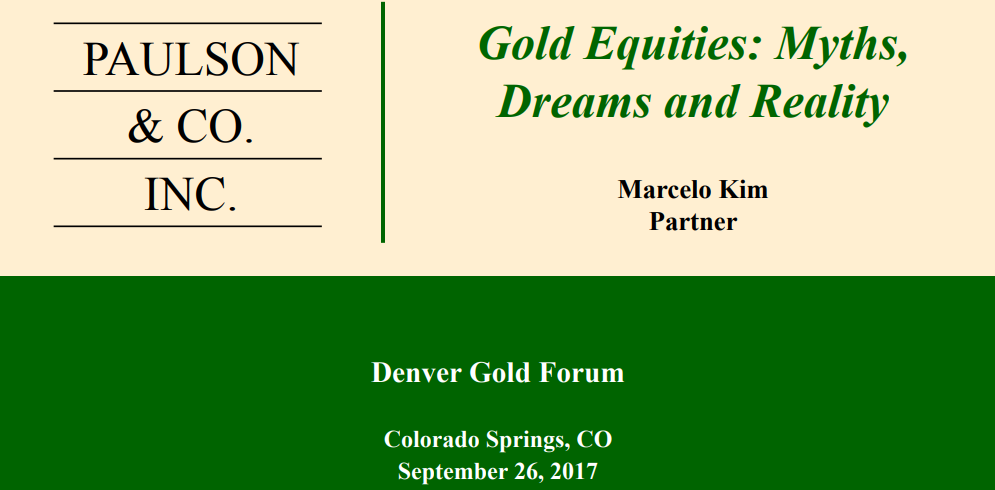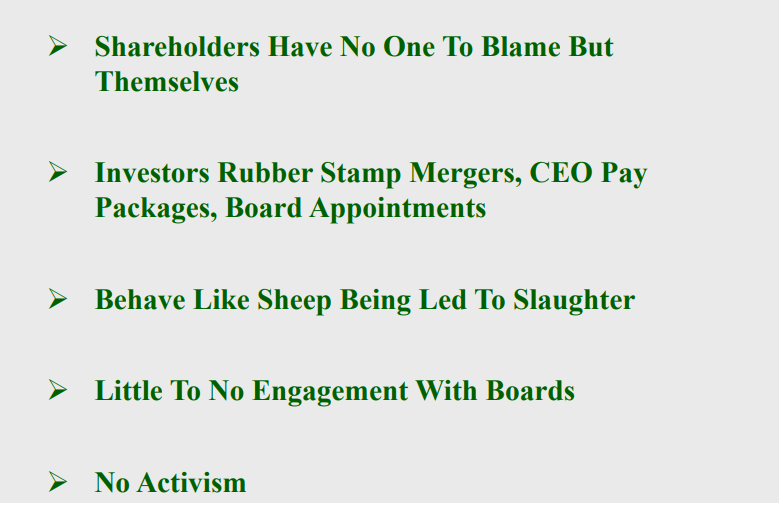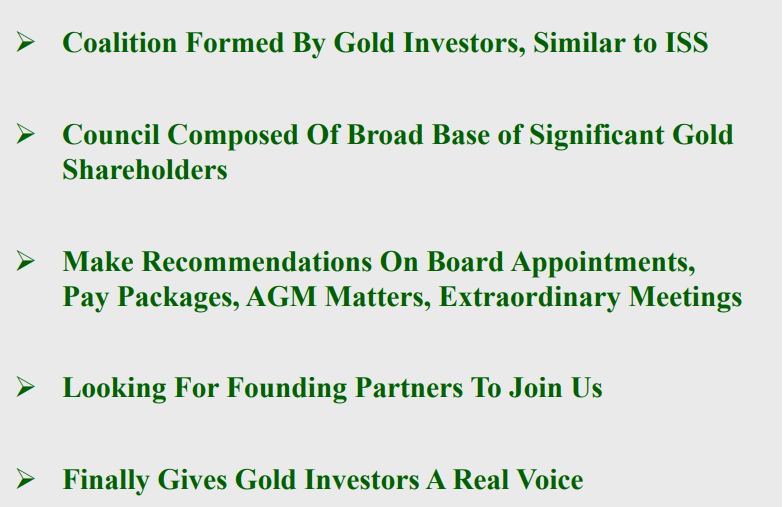The Shareholders Gold Council Ignores the Gold Price
One of the more interesting developments in the gold mining sector at the moment is the impending launch of an investor alliance called the Shareholders Gold Council (SGC) whose objectives focus on reversing the poor shareholder returns and underperformance that has been dogging the sector’s leading gold mining stocks for some time now.
This new ‘Council’, which will be activist in nature, has been spearheaded by well-known hedge fund Paulson & Co, and was first pitched to fellow institutional investors and hedge funds during a Paulson & Co presentation at the Denver Gold Forum in September 2017.
For those unfamiliar with Paulson & Co, this is a hedge fund firm established by John Paulson in 1994. Paulson’s hedge fund firm rose to prominence in the late 2000s when it shorted subprime mortgages, and correctly bet on the collapse of the US housing market. Paulson & Co pursues event-driven strategies including merger arbitrage and corporate restructurings and runs a number of funds across equities and credit. Paulson also launched a specific gold fund in 2010 called the PFR Gold Fund which according to HedgeTracker had a “long-term strategy focus investing in mining companies and bullion-based derivatives“. This fund does not invest in physical gold, as was highlighted in the BullionStar article “Are the World’s Billionaire Investors Actually Buying Gold?“.
For those unfamiliar with the Denver Gold Forum, this is an annual three-day gathering of gold and silver mining companies, major institutional and hedge fund investors which invest in the sector, and Wall Street analysts covering the sector. In fact, the Forum’s organizers claim that the event represents nearly 90% of the world’s publicly traded gold and silver companies.

According to an article by Reuters in early June, the nascent Shareholders Gold Council (SGC) has already garnered significant interest from major shareholders in the gold mining sector, and will, at the outset, represent more than 12 institutional and hedge fund investors, including investment institutions such as Delbrook Capital, Tocqueville Asset Management, Livermore Partners, and Kopernik Global Investors, and hedge funds Apogee Global Advisors and Equinox Partners, in addition to New York based Paulson & Co.
Reuters has also reported that major league institutional players such as Vanguard, State Street, Blackrock and Van Eck have also expressed interest in the SGC alliance.
High Cost Base, Destruction of Value
While hedge funds regularly attempt to turn around individual companies, the mobilization of a broad-based shareholder grouping focused on revitalizing an entire sector is still quite unusual, even for Wall Street. It is therefore instructive to examine what motivated Paulson & Co to roll out this idea and pitch the alliance to an entire institutional investment community. Although media coverage has been quite sketchy and exact details of the coalition remain unclear, the Denver presentation given by Paulson & Co’s natural resource specialist, Marcelo Kim provides some clarity, and is therefore worth reviewing.
According to Kim’s presentation ‘Gold Equities: Myths, Dreams and Reality‘, given to the Denver Gold Forum on 26 September 2017, the bottom line is that major gold mining stocks have been severely under-performing both the gold price and the broader equity indices for some time now.

This stock underperformance, thinks Paulson & Co, is due to poor investment decisions by said gold mining companies, destruction of enterprise value / low return on capital, and massive writedowns on ill-judged acquisitions, all in an environment of gigantic pay and compensation packages to gold mining company CEOs, clubby and cronie appointments to the companies boards of directors, and low stock ownership (but high options ownership) by these same company executives and board members. According to Paulson’s Kim, “CEOs and Boards get rich while shareholders lose money“.
To illustate, Kim in his presentation highlighted that from January 2010 to September 2017, a timeframe in which the US dollar gold price fell by 20%, the VanEck Vectors Gold Miners ETF (GDX) [which tracks the NYSE Arca Gold Miners Index] returned a negative 45%. Shareholder returns in the junior mining sector were even worse, with the VanEck Vectors Junior Gold Miners ETF (GDXJ)[which tracks the MVIS Global Junior Gold Miners Index] down by 58% over that time-frame.
Even more worryingly, total shareholder returns from 13 large publicly listed gold companies over the January 2010 to September 2017 period was an average negative 65%. However between 2010 and 2016, CEO pay in these same 13 leading gold mining companies was a combined US$ 550 million.
These 13 companies were Eldorado, Newcrest, Newmont, Gold Fields, Barrick, GoldCorp, Yamana, Kinross, AlgloGold, Agnico, Polymetal, Randgold, and Iamgold. All of these companies are members of the World Gold Council except for South African miners Gold Fields and Randgold and the Russian miner Polymetal. Notably, Randgold and Polymetal bucked the trend with relatively healthy shareholder return since 2010 of 35% and 20%, respectively, as well as the highest return on capital (RoC).
Additionally, over the 2010 – 2017 period, the gold mining industry had, according to Paulson and Co “written off $85 billion due to overpaying for acquisitions and massive cost overruns on mine builds“. Gold mining shareholders, said Kim, have no one to blame but themselves, as they had little engagement with company boards, chose not to engage in shareholder activism, but all the while continued to rubber stamp CEO pay, board appointments and mergers and acquisitions. Gold mining shareholders were in short, “like sheep being led to slaughter".

Paulson’s Call to Action
The solution, according to Paulson & Co, is shareholder representation on company boards, investor rights agreements with company boards, company accountability to shareholders, the sacking of poor performing CEOs and board members, and the alignment of CEO compensation with share price performance. As all of these tactics are typical activist hedge fund tactics, it’s not really surprising that Paulson, as an activist hedge fund firm, would make these suggestions.
However, it is in the modus operandus and implementation of the scheme that there is arguably a more radical departure, since this is where the Shareholders Gold Council (SGC) comes in, with Paulson calling for a Council comprising a broad base of major (institutional) gold mining equity holders to come together and make recommendations on board appointments, CEO pay, company takeovers, as well as to make recommendations on annual general meeting (AGM) and extraordinary general meeting (EGM) voting decisions.
But still, is this really a new departure? In one way it is not, because there are perfectly good proxy advisory firms, such as Institutional Shareholder Services(ISS) and Glass, Lewis and Co which between them provide the same type of corporate governance and proxy voting research that Paulson’s Shareholders Gold Council is envisioning, and that are specialists in doing so for every major listed company in the world including every major exchange listed gold mining company.

Paulson and Co’s presentation even mentioned ISS, saying that the new Council would be ‘similar to ISS‘. According to Reuters’ June article, the Paulson led Council “will begin by releasing research reports on the gold mining sector… betting that shining spotlight on the space will result in greater accountability“. But is this just more of the same?
From a coverage standpoint, there are already countless sell-side (Wall Street) research reports covering all of the world’s leading gold mining companies that are published by a host of investment banks, in addition to umpteen buy-side research reports on the gold mining sector published by countless investment institutions and hedge funds, as well as the aforementioned governance and proxy voting research reports published by ISS and Glass Lewis.
If this new Shareholders Gold Council succeeds in gaining board level representation and in influencing investment and acquisition policy, and CEO compensation and board appointments, then this may in some way make a difference to future shareholder returns in the sector. But at this stage its impossible to say what type of influence, if any, such a Shareholders Gold Council would generate.
The Elephant in the Room
There is one topic, however, that an investor led Shareholders Gold Council could research, analyse and investigate, but for some mysterious reason has chosen not to. This is an issue that goes to the heart of a gold mining company’s operations and the performance of its share price. We are talking here about the actual gold price, how that gold price is discovered and established in today’s gold markets, whether that gold price is manipulated by bullion bank traders, and whether that gold price is subject to central bank interventions that attempt to control and stabilize it.
Simply put, the price that gold mining companies receive for their gold mining output is the most important driver of gold mining share price performance, and not the company’s cost base. We are assuming here that gold mining companies do not hedge their sales. Just look at how gold mining company stocks perform in an environment of a strongly rising or strongly falling gold price. The stock prices move up or down strongly since they are highly leveraged to corresponding gold price changes.
Take for example a simple model of a gold mining company. Its total revenue will depend on how much gold it extracts, processes and sells, and at what price it sells this gold. That’s the top line. The bottom line will be the profits remaining after subtracting total costs incurred by the mining company, which to some extent are fixed. These costs include operating costs (mining costs, processing costs, and corporate, general and administrative costs) and capital expenditure etc. Beyond this, impairments and writedowns on investments will also create an extra hit, as well as merger and acquisition costs.
As the gold price is most often quoted and understood in a price per ounce, the gold mining sector and the investment analysts which cover this sector like to calculate corresponding cost per ounce metrics, including operating costs per ounce of gold produced, total cash costs per ounce, and more recently an All-In Sustaining Cost (AISC) per ounce.
Total cash cost is a historic metric that was devised by the now defunct Gold Institute. It can be viewed as a standard metric for production cost in the gold mining sector. Cash costs would include all costs associated with producing the gold, such as direct production costs, smelting, refining, transport, and administration costs of a mine.
All-In Sustaining Cost (AISC) is a metric introduced by the World Gold Council in June 2013 which aims to try to reflect costs beyond cash costs. AISC includes cash costs but then adds other costs such as general administrative expenses (head office costs) and costs associated with maintaining and replenishing a mining company’s operations, i.e. for sustaining production. It thus includes capital expenditure and exploration costs.
So what Paulson & Co’s Shareholders Gold Council is planning, in addition to publishing research reports, is to try to have an impact on cost reduction, such as reducing CEO and board compensation, as well as to prevent gold miners making costly mistakes on acquiring overvalued mines which they will then have to take writedowns on in the future. This may all be very logical and make a difference in some way, but what the Shareholders Gold Council is not planning to do is to analyse and research anything about the gold price, which is, as was just stated above, the most important determinant of shareholder return and price performance in the gold sector.
Resources & Firepower, but Don’t mention the Gold Price
The Shareholders Gold Council, which on paper will have immense research resources and firepower and influence, will not it seems devote any time or resources to questioning anything to do with the gold price and will just take it a a given. This to me is a completely lost opportunity given that there is ample material for analysis in this area, some of which would surprise institutional and hedge fund investors in the gold space if they bothered to look. Much of this material has been documented on this website and elsewhere, such as by GATA.
The entire structure of the world’s largest and most influential contemporary gold markets has little to do with physical gold. The gold price is predominantly established and discovered in two markets, the London Gold Market and the COMEX gold futures market which between them trade very little physical gold but do trade vast quantities of synthetic gold and gold derivatives. See ‘What sets the Gold Price – Is it the Paper Market or Physical Market?‘.
The vast majority of ‘gold’ trading in the London Gold Market is of unallocated gold which is merely a claim against a bullion bank, and is a form of synthetic or paper gold in as much of a way as the gold futures derivatives that trade on COMEX are. See ‘Bullion Banking Mechanics‘ and an accompanying infographic for details. All gold demand that flows into unallocated paper gold by definition does not flow into physical gold demand, a gold miner’s bread and butter. So unallocated gold syphons off real physical gold demand into a paper substitute and suppresses real demand for physical gold.
There is no trade reporting in the London Gold Market, and the London Bullion Market Association (LBMA) whose remit it is to release it has continually stalled on publishing any trade reporting. This reinforces the opacity of the one of the main gold markets which is responsible for gold price discovery. Nor is there any transparency about where major gold-backed ETFs such as GLD, that store their gold in the London gold vaults, actually source this gold from, some of which is borrowed from central banks.

Nor it there any reporting of any activity in the London gold lending market or of outstanding central bank gold loans or gold deposits. Central bank gold loans are therefore another suppressing influence on the gold price.
This is also ample evidence that the Bank for International Settlements has continually taken a keen interest in the ‘free market’ price of gold and has at times discussed at the highest levels (i.e. the governors of major central bank) how to control the gold price. See ‘New Gold Pool at the BIS Basle, Switzerland’ Part 1 and Part 2.
The COMEX gold futures market is in effect a casino which has a huge influence on gold price discovery but where little physical gold ever changes hands. Some major bullion banks have also been fined recently for manipulating the gold price. These are the same bullion banks which ran the London Gold Fixings and which now run the LBMA Gold Price auctions, auctions whose prices the gold mining companies take to sell their gold output at.
Generally speaking, gold mining executives don’t want to touch any subject related to the gold price, nor does its representative body the World Gold Council. Now it seems, the institutionally backed Shareholders Gold Council likewise does not want to broach the ‘gold price’ subject.
Which is a shame, for by not examining the issue, and by not using some of their research resources to analyse and investigate and to ‘write reports‘ on the ample evidence of structural inefficiencies and interventionalist forces that hold back the gold price, Paulson’s Shareholders Gold Council, in the same way as the gold mining shareholders which they criticize, will remain “like sheep being led to slaughter".
Popular Blog Posts by Ronan Manly
 How Many Silver Bars Are in the LBMA's London Vaults?
How Many Silver Bars Are in the LBMA's London Vaults?
 ECB Gold Stored in 5 Locations, Won't Disclose Gold Bar List
ECB Gold Stored in 5 Locations, Won't Disclose Gold Bar List
 German Government Escalates War On Gold
German Government Escalates War On Gold
 Polish Central Bank Airlifts 8,000 Gold Bars From London
Polish Central Bank Airlifts 8,000 Gold Bars From London
 Quantum Leap as ABN AMRO Questions Gold Price Discovery
Quantum Leap as ABN AMRO Questions Gold Price Discovery
 How Militaries Use Gold Coins as Emergency Money
How Militaries Use Gold Coins as Emergency Money
 JP Morgan's Nowak Charged With Rigging Precious Metals
JP Morgan's Nowak Charged With Rigging Precious Metals
 Hungary Announces 10-Fold Jump in Gold Reserves
Hungary Announces 10-Fold Jump in Gold Reserves
 Planned in Advance by Central Banks: a 2020 System Reset
Planned in Advance by Central Banks: a 2020 System Reset
 Gold at All Time Highs amid Physical Gold Shortages
Gold at All Time Highs amid Physical Gold Shortages






 Ronan Manly
Ronan Manly 0 Comments
0 Comments










